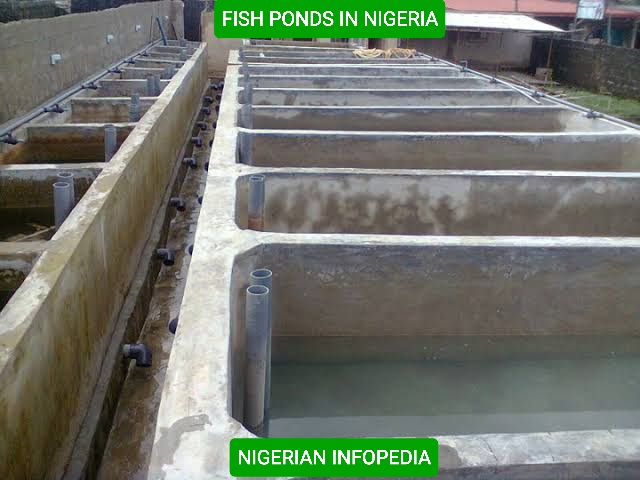Types of Fish Ponds in Nigeria
One of the most profitable businesses to start in Nigeria is fish farming. The type of fish pond for your fish farming business will depend on a number of factors, such as your financial strength, the number of fishes you want to produce, and the location of your farm, among others. If you consider building a fish pond in a highly controlled environment, you can breed fish by having artificial fish ponds.

In Nigeria today, there are different types of fish ponds, including concrete, earthen, mobile, cage and pen, and plastic tanks. Many fish farmers across the world have frequently expressed uncertainty about the various sorts of ponds that can be used to breed fish. In this post, I’ll go through the many kinds of ponds used for fish farming, along with the benefits and drawbacks of each kind of pond.
WHAT ARE FISH PONDS?
A fish pond is a location where fish are farmed for either personal or commercial use. It can also be defined as an artificial lake, or reservoir that is stuffed with fish and used for aquaculture (fish farming), recreational fishing, or ornamental purposes. Some of these ponds offer convenience because you can fish in them at home and sometimes they can be moved about with ease.
TYPES OF FISH PONDS FOR FISH FARMING IN NIGERIA
The following are the various types of fish ponds found in Nigeria today:
CONCRETE FISH PONDS
The construction of concrete ponds include using hollow blocks filled with a concrete mixture or reinforced concrete slabs. Ponds made of concrete are typically built in urban settings. Due to the scarcity of land in these places, an earthen pond cannot be constructed. Make sure there is a suitable drainage system while building concrete ponds.
Concrete ponds are more expensive than clay ponds but are much simpler to maintain because they are reasonably inexpensive. In comparison to earthen ponds, they also cost more to maintain. Make sure the ponds you construct out of concrete aren’t too large. This is due to the fact that large ponds need to be reinforced with rods, which can put a hole in your wallet because building reinforcements is quite expensive and so raises the cost of construction.
To guarantee adequate drainage, it should be noted that the water inlet should be situated on the higher level of the pond and the water outlet should be situated on the lower level. Swampy ground is not the best location for a concrete pond; upland is. The price of plumbing, cement, gravel, and sand, the price of fertilizer, as well as the cost of labor in the form of farm hands and assistance, should all be taken into account while building a concrete pond. Before constructing a concrete pond, all of these must be taken into account.
Concrete ponds have a number of benefits after construction, including high productivity and yields that result in consistent sales. Managing concrete ponds is simple. Predation is reduced since they have high agricultural security. The process of running the farm is made simple by the ease of sorting the fish. The following are some drawbacks of concrete ponds: It is absolutely necessary to build a drainage system while building a concrete pond. Ponds made on concrete also need a lot of water.
CAGE AND PEN FISH PONDS
Rivers, streams, and lagoons are where cage and pen culture systems are commonly used. The fish would be raised in open water in pens, which are enclosures with shallow water. These pens are installed on the water’s surface. The cages are fixed to the water’s surface and suspended in the water. Some of the benefits of constructing cage and pen ponds include,
Given that they are raised in oceans, fish like to eat natural food (their natural habitation). You are also free to stock however many fish you choose. Fish bred in this style of pond typically grow more quickly.
Some issues with cages or pen fish ponds include: water pollution may occur, causing you to lose all of your fish. This kind of pond is susceptible to poaching. You would need strict security in order to be successful breeding fish in this style of pond. Its expensive too
EARTHEN FISH PONDS
This kind of pond just requires a minimal amount of planning during construction. Whatever design you choose, as long as it satisfies the requirements of the fish you intend to produce, is OK. The primary criterion is access to a reliable source of steady water, meaning that the pond must be adjacent to one. It is possible to build this kind of pond manually or automatically. It doesn’t matter how you build it; it all depends on your financial resources.
A system known as an earthern pond includes creating ponds on undeveloped land. In order to construct an earthen pond, a hole between 1 and 2 meters deep must first be dug. This kind of fish pond is one that some farmers choose to construct in swampy locations. These farmers fill the pond with natural water and then manage it to prevent overflow because floods may cause significant loss and damage.
If natural water isn’t accessible and the earthen pond isn’t built in a swampy location, you may always use an electric pump to pump water. All you have to do is watch out for any signs of water buildup.
You must take the geography of the land into account before constructing this kind of pond. Make sure the water outlet is on the lower level and the water inlet is on the higher side of the land. This specific action stops floods. Make sure the pond is neither too shallow or too deep as well. If your pond is too shallow, it could flood after a rainstorm and expose your fish to potentially harmful predators. The farmers won’t be able to properly manage the property during harvest if the pond is too deep, which could be an issue.
A few benefits of earthen ponds include their low cost of construction and lack of electricity. The likelihood of disease outbreaks is comparatively low, and farm management does not require special training. How about the drawbacks? Due of the farms’ underdeveloped locations, Earthern Ponds have low sales. Fish in clay ponds are vulnerable to danger and poaching. Also having a low stocking viscosity are earthern ponds. Pollution and environmental concerns are present around the pond. Fish sorting may be challenging in the earthen pond system, and the rate of recovery is relatively poor.
TARPAULIN FISH PONDS
The tarpaulin pond is the next pond type that can be used to raise or breed fishes. The most popular type of fish pond is this one, followed by earthen, concrete, and plastic ponds. Both wood and galvanized pipes may be used to build it, and a tarpaulin may then be used to cover it. Tarpaulin pond is available in many shapes and sizes.
The tarpaulin pond has a few advantages over other pond designs, one of which is its simplicity of setup. Before setting up a tarpaulin pond space, consider that you don’t need a lot of room to build a tarpaulin pond, you still need to make sure the it is free of any obstructions that could rip the tarpaulin. It is advised against using a tarpaulin pond if you want to fish on a large scale because you will end up spending more money putting it up in the long run than if you use a concrete or earthen pond.
Consult with experts who are knowledgeable about the best tarpaulin to use and purchase it from them to avoid financial loss. Due to its flexibility, the downside of constructing a tarpaulin fish pond is that it is readily rippable, the pond can be quickly destroyed by strong winds, rain, or floods. It is also simple to disassemble and steal tarpaulin ponds.
MOBILE/PLASTIC FISH PONDS
Farmers without property use a pond system called a mobile fish pond system. This pond system is often used by farmers who reside in rented structures. It is made of wood or plastic. The plastic holding tanks are correctly built with pipes that bring in water and take it out, and they are kept with a roof over them. The fish pond’s pipes control the water’s purity. Consider the expense of purchasing the wood or plastic tanks before building this type of pond system. Also take into account the price of building the borehole that would be utilized to feed the tanks with water. The price of installing the pipes that deliver water into and out of the tank is another aspect to take into account.
The ability to disassemble and relocate the pond at any moment is just one of the numerous benefits of the mobile fish pond system. Mobile fish ponds make the best use of both water and land. They don’t require expensive installation and building. The fact that the farms are situated in metropolitan areas means that the by-products are more expensive, which is another benefit of mobile fish ponds. Additionally, since the pond is simple to operate, maintenance costs are inexpensive.
COST OF CONSTRUCTING A FISH POND IN NIGERIA
There are some factors to consider to know how much it would cost to build a fishing pond in Nigeria.
A fish pond’s construction isn’t that difficult. Depending on the quantity and size, a budget of ₦250, 000 to ₦350,000 or more should be enough to pay for the construction of ponds. The cost of digging a bore hole, plumbing work for both the inlet and outlet of the facility are what makes building a fish pond expensive
CONCLUSION
Ponds are equally crucial to the other requirements of fish farming as the other items you need to start a successful fish farm business. Your farm’s location, size, the number of fish you desire to raise, and other factors will all influence the types of ponds you choose to use. This article provides the necessary information on the different pond types available for fish farming in Nigeria.
